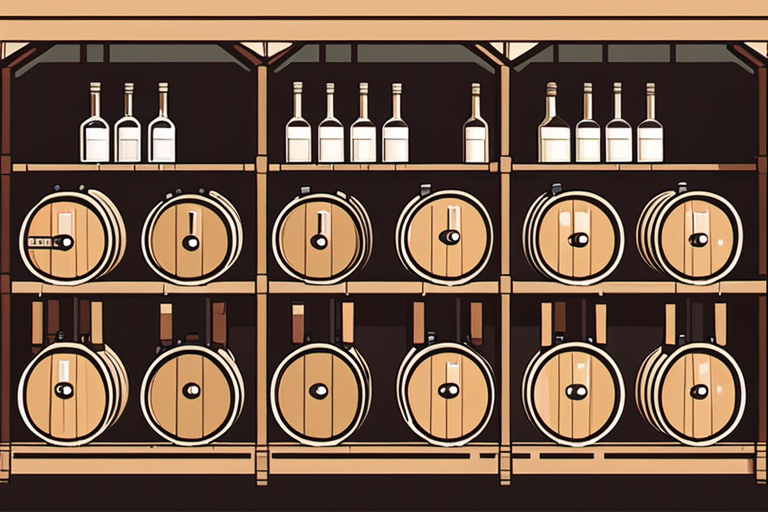
The Ultimate Guide to Properly Storing Barrel Aged Barleywine for Optimal Freshness
Get Your Free Food Safety Cheat Sheet
30 most common foods with instant answers. Print it and stick it on your fridge—completely free!
The Ultimate Guide to Properly Storing Barrel Aged Barleywine for Optimal Freshness
Barrel-aged barleywine is a prized possession for many beer enthusiasts. Its rich, complex flavors and aromas develop over time, making it a valuable addition to any beer collection. Proper storage is essential to maintain its quality and freshness. In this guide, we will explore the best practices for storing barrel-aged barleywine to ensure it reaches its full potential when enjoyed. (Barrel aged barleywine)
Understanding Barrel Aged Barleywine
Before diving into storage tips, let's first understand what barrel-aged barleywine is. This style of beer is characterized by its high alcohol content, malty sweetness, and often intense flavors resulting from aging in oak barrels. The aging process allows the beer to absorb the unique characteristics of the wood, such as vanilla, caramel, and oak notes, enhancing its complexity.
Key Characteristics of Barrel Aged Barleywine:
- High alcohol content (typically above 10% ABV)
- Rich maltiness with caramel and toffee flavors
- Oak and vanilla undertones from barrel aging
- Complex and intense flavor profile
Now that we have a better understanding of barrel-aged barleywine, let's explore how to store it properly to preserve its quality and freshness.
Proper Storage Conditions
Maintaining the right storage conditions is crucial for preserving the flavors and aromas of barrel-aged barleywine. Follow these tips to ensure optimal freshness:
1. Temperature Control
- Store barrel-aged barleywine in a cool, dark place away from direct sunlight and temperature fluctuations.
- The ideal storage temperature is around 55-60°F (12-15°C) to prevent oxidation and off-flavors from developing.
2. Humidity Levels
- Maintain moderate humidity levels in the storage area to prevent the corks from drying out and compromising the seal.
- Aim for a humidity range of 50-70% to keep the cork in good condition.
3. Vertical Storage
- Store bottles of barrel-aged barleywine vertically to keep the cork moist and maintain a tight seal.
- Vertical storage also helps prevent sediment from settling at the bottom of the bottle and getting stirred up when pouring.
4. Avoid Strong Odors
- Keep barrel-aged barleywine away from strong odors, as the beer can absorb unwanted flavors from its surroundings.
- Store it away from food items with potent aromas to preserve its original taste.
5. Limited Light Exposure
- Protect barrel-aged barleywine from exposure to light, especially UV rays, which can skunk the beer and lead to off-flavors.
- Consider storing bottles in a dark cellar or using opaque storage containers to shield them from light.
Safety Precautions and Handling Tips
Ensuring the safety of your barrel-aged barleywine is essential to prevent spoilage and maintain its quality. Follow these safety precautions and handling tips:
1. Check for Leaks
- Before storing barrel-aged barleywine, inspect the bottle for any leaks or damage to the cork.
- A compromised seal can lead to oxidation and contamination, affecting the beer's taste.
2. Handle with Care
- When moving or handling bottles of barrel-aged barleywine, do so gently to avoid disturbing any sediment that may have settled.
- Sudden movements can agitate the beer and impact its clarity and flavor.
3. Monitor Storage Conditions
- Regularly check the storage area for any changes in temperature, humidity, or light exposure that may affect the beer.
- Make adjustments as needed to maintain the optimal storage conditions for barrel-aged barleywine.
4. Rotate Stock
- If you have a collection of barrel-aged barleywine, consider rotating your stock to ensure that older bottles are consumed first.
- This practice helps prevent the beer from aging past its peak and allows you to enjoy it at its best.
5. Labeling and Organization
- Keep track of the aging dates and storage locations of your barrel-aged barleywine bottles by labeling them accordingly.
- Organize your collection based on aging timelines or flavor profiles to easily identify and access specific bottles.
Conclusion
Proper storage of barrel-aged barleywine is essential to preserve its unique flavors and aromas. By following the guidelines outlined in this guide, you can ensure that your prized beer remains fresh and enjoyable for years to come. Remember to maintain the right temperature, humidity levels, and storage conditions, handle the beer with care, and monitor its surroundings regularly. With these practices in place, you can savor the rich complexities of barrel-aged barleywine to the fullest.
For more information on barrel-aged barleywine and other beer storage tips, visit our [barrel-aged barleywine](/food/barrel aged barleywine) page. Cheers to enjoying your perfectly stored barrel-aged barleywine! (Barrel aged barleywine)

Authoritative Food Safety References
These agencies and university labs inform every tip and health precaution we publish.
USDA FoodKeeper – Cold Storage Guidelines
Official refrigerator, freezer, and pantry timelines maintained by the U.S. Department of Agriculture.
Visit USDA FoodKeeperFDA Produce Safety Rule & Grower Guidance
Field-to-fridge handling practices that prevent contamination of fruits, vegetables, and leafy greens.
Visit FDA Produce SafetyCDC Foodborne Illness Prevention Hub
Surveillance-backed guidance on pathogens, symptoms, and steps to reduce foodborne illness risk.
Visit CDC Food SafetyUC Davis Postharvest Technology Center
University research detailing optimal storage atmospheres for produce after harvest.
Visit UC Davis PostharvestPenn State Extension – Home Food Preservation & Safety
Peer-reviewed extension bulletins on safe canning, chilling, and reheating practices.
Visit Penn State ExtensionCan I age barrel aged barleywine for an extended period of time?
How long can I store barrel aged barleywine before it goes bad?
Should I refrigerate barrel aged barleywine?
Can barrel aged barleywine be stored upright or on its side?
Get Your Free Food Safety Cheat Sheet
30 most common foods with instant answers. Print it and stick it on your fridge—completely free! Want more? Upgrade to the complete guide with 70+ foods.
Scan your food directly and get instant safety info using our AI-powered camera feature.